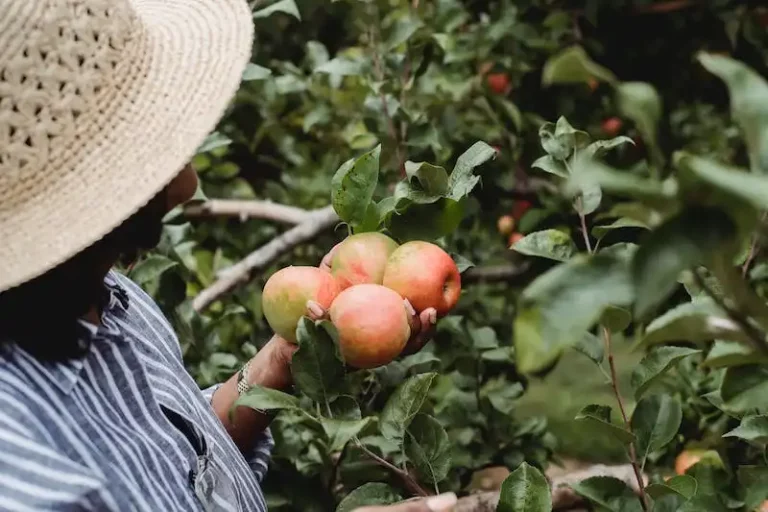The pear tree is a popular fruit-bearing tree that is enjoyed by gardeners and fruit enthusiasts alike. It is a source of delicious pears, which can be eaten fresh, utilized in recipes, or preserved for later use. This versatile tree can be found in orchards around the world.
Caring for a pear tree is relatively simple, making it a great choice for both experienced gardeners and beginners. The tree moves from a dormant state during the winter to a healthy and flowering tree in the spring. Regular pruning and watering are important for maintaining a healthy pear tree.
One of the best ways to care for a pear tree is to provide it with a thick layer of mulch. This will help retain moisture in the soil and prevent weeds from competing with the tree for nutrients. Adequate watering is also crucial, especially during the summer months when the temperature rises.
The pear tree can be susceptible to attacks from pests and diseases, such as fireblight. To combat these issues, spraying with a liquid solution or using organic pest control methods can be effective. It’s important to consult with your local gardening center or online resources to find the best methods for your specific location.
When it comes time for harvest, the pear tree will yield medium-sized pears that are sweet and flavorful. Some popular pear varieties include the Kieffer, a standard variety, and the Gourmet, a southern favorite. The pears can be picked and enjoyed as soon as they are ripe.
In conclusion, the pear tree is an excellent addition to any garden or orchard. With proper care and preparation, it will provide a bountiful harvest of delicious pears. Whether you’re a seasoned gardener or new to fruit trees, the pear tree is a great choice that will bring beauty and abundance to your outdoor space.
Pear Trees
Pear trees are a common fruit tree that is usually grown in home gardens and orchards. They are known for their delicious and sweet fruit, which is loved by many people. However, like any other plant, pear trees can also suffer from various problems. It is important to know about these issues in order to take the necessary steps for prevention and care.
Sunscald and Diseases
Pear trees are prone to sunscald, especially during the initial growth stages. Sunscald occurs when the bark on the trunk and branches is exposed to high temperatures and direct sunlight. This can cause the bark to crack and peel, leaving the tree vulnerable to diseases and pests. To prevent sunscald, it is recommended to wrap the trunk with a light-colored tree wrap or paint it with a diluted white latex paint.
There are also several diseases that can affect pear trees, such as fire blight, which is a bacterial infection that can cause the branches to die and turn black. It is important to prune any infected branches and apply appropriate fungicides to prevent the spread of disease.
Tree Care and Maintenance
When planting a pear tree, it is important to choose a well-spaced location with good drainage and full sun exposure. The tree should be planted in a hole that is wide and deep enough to accommodate the roots, and the soil should be amended with compost or aged manure for better nutrition.
Regular watering is essential for the healthy growth of pear trees, especially during hot and dry periods. The tree should be watered deeply, allowing the water to reach the root zone. Mulching around the base of the tree helps to retain soil moisture and suppress weed growth.
Fruit Production and Harvest
Pear trees usually produce their first fruit after 3-5 years of planting. The fruits should be left on the tree until they have reached their mature size and color. The best way to determine if a pear is ripe is to gently press the skin near the stem. If it gives slightly, then the pear is ready to be picked.
When harvesting pears, it is important to gently twist and pull them from the tree to avoid damaging the stem or the fruit. Pears should be handled with care to prevent bruising, as they can easily spoil. Proper storage and preparation methods can help to keep pears fresh and tasty for longer.
Common Pear Varieties
- Bartlett: One of the most commonly grown pear varieties, known for its sweet and juicy flesh.
- Anjou: A versatile pear that can be eaten fresh or used in cooking and baking.
- Bosc: A firm and crisp pear variety that is well-suited for canning and baking.
- Asian Pear: A pear variety with a crisp texture and a sweet flavor, commonly used in Asian cuisine.
- Comice: A gourmet pear known for its buttery texture and sweet flavor.
Overall, growing pear trees can be a rewarding experience for home gardeners. By following the proper guidelines and taking care of the tree’s needs, you can enjoy a bountiful harvest of delicious and healthy pears year after year.
Source: online article “Pear Tree Care and Growing Guide” [URL]
Pear Tree
A pear tree is a medium-sized fruit tree that is commonly grown in gardens and orchards. It belongs to the genus Pyrus and is known for its excellent fruit production. Pear trees are available in various varieties, with the most commonly planted being the Bartlett variety.
When selecting a pear tree for planting, it is important to choose a healthy tree with a strong rootstock. This will ensure that the tree can survive and thrive in its new environment. Pear trees prefer a sunny location and well-drained soil. They also require regular watering, especially during dry seasons.
To care for a pear tree, regular pruning is necessary to maintain its shape and promote healthy growth. It is also important to provide support for the tree, especially when it starts producing fruit. Mulching around the base of the tree helps to retain moisture and suppress weed growth.
Pear trees typically flower in the spring and produce fruit in the late summer or early fall. The fruit should be left on the tree until it is fully ripened before harvesting. It is essential to handle the fruit with care to avoid bruising.
In terms of temperature, pear trees prefer a moderate climate. They are better suited for regions with mild winters and warm, sunny summers. However, there are some varieties that can be grown in colder climates, although they may require additional protection during severe weather.
When it comes to fertilizing pear trees, a balanced fertilizer with a ratio of nitrogen, phosphorus, and potassium is recommended. This will provide the tree with the necessary nutrients for healthy growth. Fertilizer should be applied in the spring and again in the fall to promote optimal fruit production.
Pear trees are considered to be a good source of fiber and vitamin C. They are also low in calories, making them a healthy snack option. The fruit can be eaten fresh, used in cooking and baking, or made into preserves and jams.
In conclusion, growing a pear tree at home can be a rewarding experience. By following the guidelines for planting, care, and maintenance, you can enjoy a bountiful harvest of delicious pears year after year.
Standard Select Pear Trees
When it comes to selecting a pear tree for your home garden, standard select pear trees are a popular choice. These trees produce flavorful fruit that can keep for years when properly cared for. Standard select pear trees are known for their vigorous growth and ability to bear abundant fruit.
Caring for standard select pear trees starts with proper watering. During the growing season, regular watering is necessary to keep the tree healthy and ensure optimal fruit production. However, be careful not to overwater the tree, as this can lead to root rot. Watering should be reduced during the dormant season.
Pruning is also an important aspect of caring for standard select pear trees. Pruning helps to shape the tree and remove any diseased or damaged branches. It also promotes airflow and sunlight penetration, which is crucial for fruit development. Pruning should be done in late winter or early spring before the tree starts to leaf out.
Standard select pear trees have a mixture of branches, including scaffolds, a single leader, and a crook. The leader is the main upright stem, while the scaffolds are the lateral branches that grow out from the leader. By pruning these branches, you’ll help the tree maintain a strong and open structure.
Standard select pear trees can be susceptible to pests and diseases, including fire blight, a bacterial disease that affects the blossoms and stems. Regular spraying with a white liquid, called Bordeaux mixture, can help prevent and control these issues.
When selecting a standard select pear tree, choose varieties that are well-suited to your climate and growing conditions. Some popular varieties include Kieffer, which produces crisp and flavorful fruit, and Bartlett, a gourmet pear known for its juicy and sweet taste.
Proper preparation before planting is also important for the success of your pear tree. Make sure you have a suitable location with well-drained soil and full sunlight. Removing any weeds or grasses and improving the soil with organic matter will help the tree establish itself. It’s also a good idea to install a fence or guard around the tree to protect it from animals.
Caring for a standard select pear tree requires some effort, but the rewards are worth it. With proper care and attention, you can enjoy a bountiful harvest of delicious pears for years to come.
Here are some tips for caring for standard select pear trees:
- Select varieties that are well-suited to your climate and growing conditions.
- Prune the tree in late winter or early spring to promote a strong structure.
- Regularly spray the tree with a white liquid, such as Bordeaux mixture, to prevent pests and diseases.
- Water the tree regularly during the growing season, but be careful not to overwater.
- Prepare the planting area by removing weeds and improving the soil with organic matter.
- Install a fence or guard around the tree to protect it from animals.
Flowering Pear Trees
Flowering pear trees, especially those of the Pyrus calleryana variety, are popular choices for landscaping due to their beautiful blossoms and hardiness. However, there are some considerations to keep in mind when caring for these trees.
Flowering pear trees are commonly found in Asia and have been cultivated for regular fruit production. The most commonly cultivated variety is the Pyrus calleryana ‘Bradford,’ also known as the Bradford pear tree. It is a medium-sized tree that usually reaches a height of 30 to 50 feet.
One important factor to consider when planting a flowering pear tree is its location. These trees should be planted in well-drained soil and in an area that receives full sun. Flowering pear trees thrive in hardiness zones 5 to 9.
Caring for flowering pear trees involves regular maintenance tasks, such as mulching, pruning, and fertilizing. Mulching helps retain moisture in the soil and prevents weed growth. Pruning should be done in late winter or early spring to maintain a desired shape and remove any dead or damaged branches.
When it comes to fertilizing, applying a general-purpose fertilizer in early spring and again in early fall is usually sufficient. However, it is recommended to follow the specific instructions provided by the manufacturer for the best results.
Flowering pear trees bloom in early spring, usually around March, with clusters of white flowers covering the tree. The flowers give way to small, round fruits that are not commonly consumed by humans. The fruit, called pomes, are more commonly used for baking and making preserves.
The bark of the flowering pear tree is smooth and gray-brown, and it turns darker as the tree ages. The leaves are glossy and have a simple oval shape. In the fall, the leaves turn shades of red, orange, and purple before dropping off.
One of the benefits of cultivating flowering pear trees is their resistance to many diseases and pests. They are generally low-maintenance trees that require minimal care. However, keep in mind that some varieties, such as the Bradford pear tree, can become invasive in certain regions, so it is important to check whether they are suitable for your area.
In conclusion, flowering pear trees are a beautiful addition to any landscape. With proper care and maintenance, these trees can thrive and enhance the beauty of their surroundings for many years to come.




